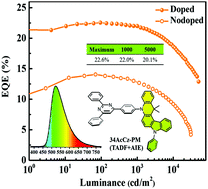Integrating TADF luminogens with AIE characteristics using a novel acridine–carbazole hybrid as donor for high-performance and low efficiency roll-off OLEDs†
Abstract
A novel acridine–carbazole hybrid donor (34AcCz: 13,13-dimethyl-8-phenyl-8,13-dihydro-5H-indolo[3,2-a]acridine) was formed from two sophisticated donors of dimethyl acridine (DMAc) and carbazole (Cz). Based on this novel donor and the acceptors of pyrimidine and triazine, two new luminogens with both prominent TADF and AIE properties, namely, 5-(4-(2,6-diphenylpyrimidin-4-yl)phenyl)-13,13-dimethyl-8-phenyl-8,13-dihydro-5H-indolo[3,2-a]acridine (34AcCz-PM) and 5-(4-(4,6-diphenyl-1,3,5-triazin-2-yl)phenyl)-13,13-dimethyl-8-phenyl-8,13-dihydro-5H-indolo[3,2-a]acridine (34AcCz-Trz), have been designed and synthesized. AIE characteristics in TADF emitters can be regulated by the selection of acceptor species, then 34AcCz-PM realized a higher photoluminescence quantum yield (PLQY) than that of 34AcCz-Trz. Finally, the maximum current efficiency (CEmax)/external quantum efficiency (EQEmax) of 73.3 cd A−1/22.6% for the doped OLEDs of 34AcCz-PM was demonstrated, which remained at 65.5 cd A−1/20.1% even at a high luminance of 5000 cd m−2. A highly efficient nondoped OLED based on 34AcCz-PM was also obtained, providing maximum EL efficiencies of 45.2 cd A−1/14.1%.



 Please wait while we load your content...
Please wait while we load your content...